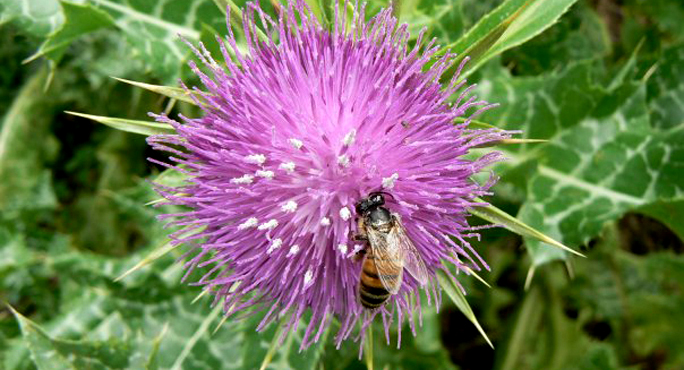Honeybee on Milk Thistle Bloom. Photo courtesy American Botanical Council
By now, pretty much everyone has heard of Colony Collapse Disorder (CCD), the mysterious and widespread disappearance of vast numbers of bees. In 2006, U.S. beekeepers sounded the alarm that they were witnessing tremendous declines in bee populations. Worker bees were abandoning their hives en masse and simply vanishing, leaving queen bees and young bees behind. Only a very few were found dead near hives. By this point the situation is very bad. Bees have died off by the billions, and there is no end to this trend in sight.
Perhaps you don’t think that much about bees and the critical role they play in nature, especially concerning the foods we eat. Bees are among the greatest of all pollinators. They fly from one plant to another, one blossom to the next, gathering nectar to make honey, and in the process, get themselves mightily covered with pollen.
And while pollen may mean seasonal allergies to many, it means life to us all. As bees travel, the pollen they carry on their bodies fertilizes plants, notably food crops. Bees pollinate many tree fruits such as apples, peaches, pears and cherries. They pollinate onions, broccoli, squash, carrots and a host of vegetables. They also pollinate a variety of field crops, including cotton, peanuts and soybeans. The bee business itself is actually quite big, with tractor trailer-loads of beehives moved from one crop to another over the course of annual growing seasons.
Estimates of the impact of CCD place losses at about $15 Billion dollars worth of food production per year if this phenomenon is not stopped. That’s just the money part of the equation. CCD could result in catastrophic losses of many basic, favorite foods. This would create enormous changes in how we eat and live.
Many different researchers have involved themselves with this issue, though the actual budgetary commitment made to investigating CCD has been tiny up to this point. There is widespread speculation about how diseases, genetically-modified crops (GMO’s), pesticides, industrial toxins and other factors may contribute to the bee die-off. Cell phones and the frequencies they transmit and receive have been subjects of much concern. I’ve even seen websites operated by religious groups calling CCD “God’s last warning.” The problem may not be any single factor by itself, but a concurrence of several at once, making bee colonies vulnerable. The hard truth is, nobody knows.
A recent announcement stemming from a collaboration between two universities, the U.S. Army and a Mexican research institute has shed new light on CCD. Scientists have identified both a fungus and a virus in bees that have succumbed to the disorder. The fungus is known as iridescent moth virus 6, and the virus is called Nosema Ceranae. This virus is similar to another one involved in the devastation of bee populations in India two decades ago. Some are hailing this most recent discovery as having solved the mystery of CCD. But the researchers involved in this recent discovery say they don’t know whether these two pathogens cause CCD, or if bees exposed to something else simply become more susceptible to these agents.
Do other environmental factors including GMO’s, pesticides and industrial toxins make the bees more susceptible to CCD? What attributes to the sudden outbreak of this baffling disease? The United States Department of Agriculture has dedicated a scant $20 million in funds to investigate this issue, and yet 2010 has already proven to be the worst year on record for bee deaths. To tackle a problem of this magnitude requires a lot more than what amounts to USDA lunch money.
A survey conducted between the Apiary Inspectors of America and the USDA found that approximately one-third of all bees in North America died this past year. CCD is continuing at a rapid clip while we re-arrange the deck chairs on the Titanic. The Environmental Protection Agency is quick to state that pesticides can’t be blamed for CCD, because when bees are killed by pesticides, they tend to die all around hives, and this is not the case with CCD. But we’ve been fed similar tales of pesticide safety before, only to discover an increasing list of health and environmental problems associated with the use of agricultural poisons on food crops. At this point it’s unrealistic to accept EPA’s declarations at face value.
I recall back when I was in my early 20’s, when I tended bees in the countryside of Western Massachusetts. I was fascinated by the almost supernatural energy the bees displayed. They buzzed in and out of the hives all day long in the warm season, working harder than any creatures I had ever seen. They pollinated nearby apple trees, alfalfa fields, flowers, our raspberry patch, and more. And at the end of the season, when I extracted some of the honey they had made, it was a heavenly and miraculous thing. The honey from the hives I tended tasted better than any honey I had ever eaten.
Bees are not just commercial pollinators. They are intrinsic to the ever-unfolding miracle of nature. Sometimes in the summer I go out to the blackberry patch in our front yard, and watch the bees. They remain endlessly fascinating to me. And yet, if CCD isn’t halted, nobody will be going out to watch bees. A massive die-off will change the face of nature, and will be one more devastating insult to the global biosphere. It’s time we step up efforts to get to the absolute core of this issue, for the good of all nature and humanity.
Medicine Hunter Chris Kilham, for FOX News Body & Mind, October 15, 2010


